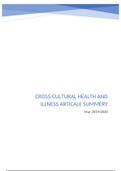CROSS-CULTURAL HEALTH AND
ILLNESS ARTICALE SUMMERY
Year 2019/2020
, LECTURES WITH CORRESPONDING ARTICLES
5. A. De Graaff, F. M., Mistiaen, P., Devillé, W.L.J.M. & Francke, A.L. (2012).
Perspectives on care and communication involving incurably ill Turkish
and Moroccan patients, relatives and
professionals
B. Mori et al. (2019). Explicit prognostic disclosure to Asian women with
breast cancer: A randomized scripted video-vignette study
6. A. Goudsmit, M., Uysal-Bozkir, Ö., Parlevliet, J.L., van Campen, J.P.C.M., de
Rooij, S.E. & Schmand, B. (2016): The Cross-Cultural Dementia Screening
(CCD): A new neuropsychological screening instrument for dementia in
elderly immigrants.
B. Nielsen, T.R., Vogel, A., Phung, T.K., Gade, A., Waldemar, G. (2011).
Over- and underdiagnosis of dementia in ethnic minorities: a nationwide
register-based study.
7. A. Parker, R. (2001). Sexuality, Culture & Power in HIV/AIDS Research.
B. Tawfik, Li. & Watkins, S. (2007). Sex in Geneva, sex in Lilongwe, and sex
in Balaka.
8. A. Steel, Z. et al. (2009). Association of torture and other potentially
traumatic events with mental health outcomes among populations
exposed to mass conflict and displacement
B. Ter Heide, J.J. et al. (2016). Eye movement desensitisation and
reprocessing therapy v. stabilisation as usual for refugees
, LECTURE 5 - DE GRAAFF, MISTIAEN, DEVILLÉ, FRANCKE - 2012
Palliative care is the care that is provided to patients who are chronically or
incurably ill. The goal is to relief the symptoms that patients experience, such as
pain or distress. Initially, palliative care was provided to terminally ill cancer
patients. Lately, however, there has been a shift which means that now a lot of
other patients, such as patients suffering from heart failure or COPD, do get a
palliative treatment. There has also been a shift in that palliative care providers
pay attention to patients with specific cultural and sociodemographic
characteristics, such as non-Western immigrants.
Studies in non-Western countries have shown that the citizens of these countries
have limited choices with regard to getting medication against pain. This is due
to poverty. It is also true that family care systems, religious belief and practices
and a traditional view on care, may influence the use of palliative care in these
countries. Other issues that cultural minorities experience in Western countries
could experience are language difficulties, health literacy difficulties or
discrimination. The way in which palliative care is available in these Western
countries might also be mismatched to the cultural and / or religious background
of the non-Western immigrants.
A clear example of how these difficulties could work out is as follows: Some
Muslim patients with incurably life-limiting illnesses who live in Europe often do
not like to seek help from professional caregivers or institutions. They would
rather use the care provided by their family and close relatives. This is due to
Negative experiences with the care services, which could be about the
food (such as not taking in account the food that is permitted for them and
providing these Muslim patients with bacon or experiencing
discrimination).
These Muslim patients are often also concerned about criticism from their
community.
Some Muslim (or other religious) patients might also believe that illness
and disease are God’s will and that it is not right to seek out professional
care.
The authors of this article found, in earlier empirical research carried out by
them, that care professionals in the Netherlands often experience difficulties in
providing good care and communication to immigrant patients. One of the
reasons for this is that they find it difficult to meet the needs of these patients
and their families. Providing good care and communication to immigrant patients
is further complicated by that some patients lack knowledge about their
diseases, that there are some strong cultural patients within their (big) families
and that there are sometimes inadequate interpreter facilities.
In the Netherlands, the Turkish and Moroccan people form the largest immigrant
group. They come from different places in the world, but they share some
important features, such as that that they often come from poor agricultural
regions, that they arrived at low-paid ‘guest workers’ between 1950 and 1980,
that they often live in deprived neighbourhoods and that most of them belong to
a Muslim minority group. The first generations of these Turkish and Moroccan are





